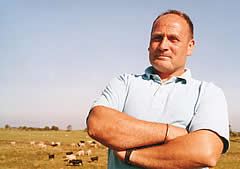 |
|||||||||
|
|||||||||||||||||||
Weighing up the options post CAP Reform with Charolais
Lewis Forster remains quietly optimistic about the future of his suckler enterprise under the new CAP Reform regime. Despite the general uncertainty of the market place for store cattle, he is confident that demand for quality beef will persist, and that his versatile Charolais crosses will continue to remain within the day’s top 5% of market prices. “I’m being practical and considering the options because no one really knows how the marketplace will react without headage support under the new regime. However I am confident that our Charolais cross calves with their ability to grow on to any weight and consistently grade within the specification will continue to command a premium,” says Mr Forster who runs 150 suckler cows and a complementary flock of 800 ewes at West Nubbock, a 460ha tenanted unit near Hexham. The majority is put to the Charolais, including the heifers, and the majority start calving indoors from late April. Thirty five of the more milky cows are put a black Limousin bull specifically to breed replacement heifers. West Nubbock’s Charolais cross calves are currently reared to an average of 18 months and sold through the strong store ring in Hexham. The unit’s latest crop of steers sold to average £755 at approximately 545kg, and heifers £654 at approximately 530kg and the majority sold to repeat buyers. “Last spring, we offered the first pen of commercial store cattle to exceed £800 per head at Hexham Mart for many years.” However from January, Mr Forster is aware that those finishers, left without second BSP payment to claim, may no longer be at the ringside. “This is a marginal hill unit located within the SDA and moorland line, so our options are immediately limited. We know from experience that we’re unable to successfully grow energy and protein crops for finishing purposes, and to date, buying in feed is not very cost effective. In addition, we don’ t have too much surplus accommodation or labour to finish our own cattle,” he explains. “We’re currently considering the optimum time to sell our calves in future. It may be at 12 months of age, however with the majority of the herd calving in spring, if we didn’t summer the cattle, we’d be left with surplus grazing. We may keep the calves on and house them early September, six weeks earlier than usual, put some finish on them and sell on to the pre-Christmas store market.” Charolais has made a recent comeback to the farm after virtually a 20 year absence. “After being culled out to FMD we had every intention to restock with commercial Limousin cattle. However, we happened to find an entire 135 cow suckler herd, plus followers, up for genuine dispersal which offered a logical way of returning to beef production,” says Mr Forster. “I was very impressed with the quality of its Charolais cross calves and it came complete with Charolais bulls which were being used across the entire herd, including the heifers, and they were leaving easy calved progeny. So we decided there and then to buy the job lot. “Since, we’ve been so pleased with the Charolais cross calves’ performance that we’ve no intention of using any other Continental terminal sire for commercial calf production on our suckler cows. Our Charolais crosses are demonstrating a superior liveweight gain for age, they’ve tremendous muscling, and they’re far easier to manage in terms of temperament.” Once again the quality of West Nubbock’s calves were officially endorsed when they were awarded runner up place in the large herds section of the Border Charolais / Pfizer Suckler Herd of the Year Award. Mr Forster continues: “As far as our Single Farm Payment is concerned, ideally we believe it should be treated as an investment, however unless there is a radical increase in market price for beef, it will have to be used, at least in the short term for support purposes. From a heifer calf being kept for breeding to selling a big calf off her, it’s at least 3.5 years. So without any costs attached, anyone can see this is a long term business and the meat industry needs to see now it has to pay more for our produce.” Regardless of which option is chosen for the suckler enterprise, Mr Forster says attention to management detail will become even more important if he is to further maximize the unit’s potential. “While we believe we are efficient, there is scope for further improvement and we can try to cut costs a little, however we will not compromise on quality. If we cannot make a profit we will simply not produce. And if we can’t produce with Charolais, then we won’t achieve it with any other breed.” |
|||||||||||||||||||

|
|
||||||||||||||||||
| home | agri-services | pedigree
pen | news | dairy | beef | machinery bps | property | organisations | site map |
|||||||||||||||||||
